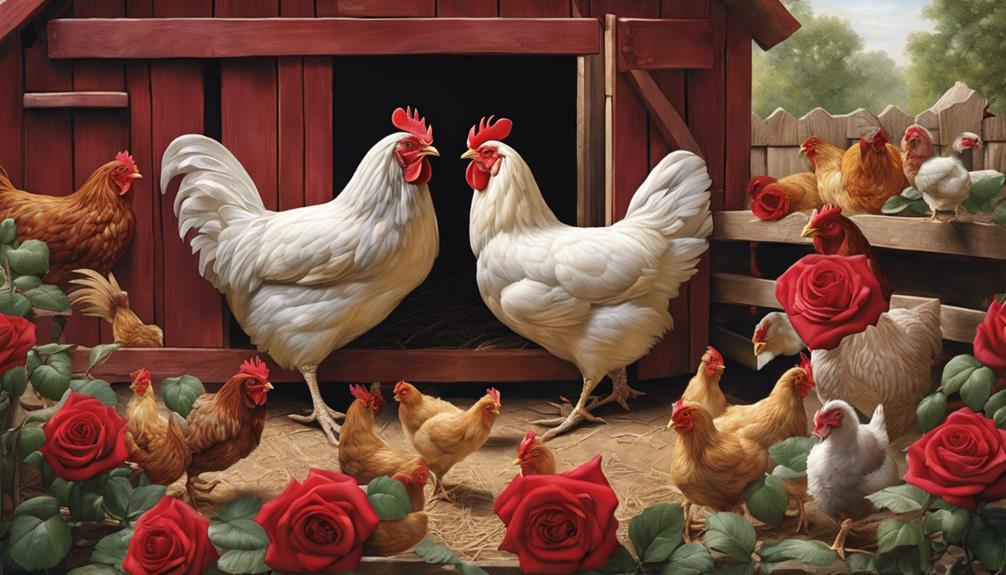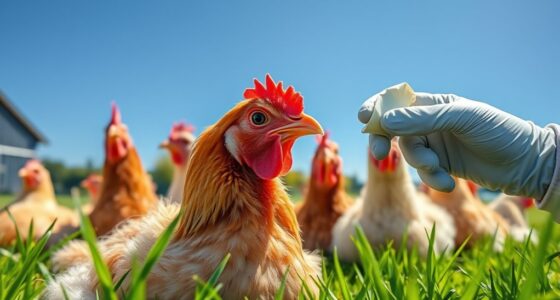Yes, it’s true—you can now have chickens that text you when they’re hungry or need water. Smart sensors monitor their activity and environment, so you get instant alerts on your phone or device. This technology helps you care for your flock more efficiently, even in small urban spaces. It reduces the need for constant checks and improves their overall welfare. Keep exploring to discover how this innovative system works and benefits urban farmers like you.
Key Takeaways
- Smart sensors monitor chickens’ activity, feed, and water levels to detect hunger or distress.
- Automated alerts send text messages or notifications to farmers when chickens need attention.
- Technology allows remote management, reducing the need for physical checks in urban farming setups.
- These systems optimize resource use and improve poultry health through real-time data.
- Such innovations support sustainable, efficient urban poultry farming with minimal labor.

Imagine a farm where chickens can send you a text message when they’re hungry, revolutionizing the way we care for poultry. This isn’t science fiction—it’s a real breakthrough in urban farming, driven by innovative poultry technology. As urban spaces grow tighter and traditional farms become less feasible, farmers are turning to smarter solutions to meet the demand for fresh, local eggs and meat. These advancements make poultry management more efficient, less labor-intensive, and more responsive to the birds’ needs.
With poultry technology integrated into your urban farm, you can monitor the health and behavior of your chickens remotely. Sensors and smart devices track activity levels, feed and water consumption, and environmental conditions. When a chicken’s food or water runs low, or if it shows signs of distress, the system sends you an instant notification—sometimes even a text message—alerting you to take action. This immediate communication helps prevent health issues before they escalate, guaranteeing your flock stays healthy and productive.
Monitor your chickens remotely with sensors that send instant alerts when they need care, keeping your flock healthy and happy.
The beauty of these systems is that they streamline daily tasks. Instead of constantly checking on each bird, you receive real-time updates and can respond swiftly. This means less time spent physically monitoring your poultry and more time focusing on expanding your urban farm or improving other aspects of your operation. Poultry technology also enables you to optimize feeding schedules, reduce waste, and maintain ideal living conditions, all from your smartphone or computer.
For urban farmers, this tech-driven approach offers a significant advantage. Space is limited, and managing poultry in tight quarters requires precision. The integration of sensors and data analytics allows you to manage your flock efficiently, minimizing resource use and maximizing productivity. Plus, with the ability to remotely oversee your chickens, you can ensure they’re comfortable and well cared for—even if you’re away from the city.
This evolution in poultry management exemplifies how urban farming is embracing technology to create sustainable, scalable food sources within city environments. It’s not just about convenience; it’s about fostering a better relationship between farmers and their animals through smarter, more compassionate care. As poultry technology continues to develop, you’ll find it easier than ever to keep your chickens happy, healthy, and productive—all while contributing to the growing movement of sustainable urban agriculture.
Frequently Asked Questions
How Do Chickens Send Text Messages to Farmers?
You might wonder how chickens send text messages to farmers. Thanks to avian innovation and digital poultry technology, these birds are now equipped with sensors and smart collars that monitor their health and hunger levels. When they need something, the devices send alerts directly to farmers’ smartphones. This seamless communication improves poultry care, making farming more efficient and responsive through advanced digital poultry systems.
What Technology Enables Chickens to Communicate Digitally?
You’re witnessing a tech revolution on farms, fueled by avian intelligence and farm automation. Tiny sensors and smart devices connect chickens to digital networks, enabling them to “send” messages through automated systems. These innovations use wireless communication and AI to interpret chicken behaviors, making it seem as if they’re texting. This seamless integration of technology transforms farm management and highlights how farm automation leverages avian intelligence in extraordinary ways.
Are These Chickens Part of a Research Experiment?
You wonder if these chickens are part of a research experiment, and it’s likely. This innovative use of technology showcases advances in animal behavior studies, allowing scientists to observe and understand how animals communicate and respond to their environment. By applying technological innovation, researchers gather valuable insights into chicken behavior, which can improve farming practices and animal welfare. So, yes, these chickens probably participate in a controlled experiment to explore new communication methods.
How Do Farmers Interpret Chicken Text Messages?
Imagine checking your phone and seeing a chicken’s message blinking on the screen, sparking avian humor and surprise. As a farmer, you interpret these chicken texts as playful signals of farm communication, blending humor with practical insight. You see these messages as a quirky, modern way chickens help you stay connected, making daily chores more engaging and reminding you that sometimes, farm life can be unexpectedly amusing and full of surprises.
Can This Communication System Be Used With Other Farm Animals?
You wonder if avian communication can extend to other farm animals. While chickens use innovative signals like text messages for farm automation, it’s unlikely other animals will adopt similar methods soon. Researchers are exploring ways to interpret animal behaviors and develop tech to facilitate this. For now, focusing on avian communication advancements helps improve farm automation, but applying it to other species remains a challenge for future innovations.
Conclusion
Imagine a world where chickens communicate their needs directly to you, blurring the line between human and animal. These texting hens remind us that connection and understanding can be found in the most unexpected places. As you consider their cleverness, remember that nature often whispers truths we’ve yet to hear—if only we listen closely. After all, isn’t it astonishing how even the simplest creatures can teach us the language of empathy?










